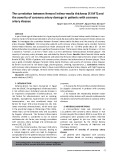
7
Journal of Medicine and Pharmacy, Volume 11, No.07/2021
The correlation between femoral intima-media thickness (F.IMT) and
the severity of coronary artery damage in patients with coronary
artery disease
Nguyen Quoc Viet1, Ho Anh Binh2*, Nguyen Phuoc Bao Quan2
(1) Da Nang General Hospital, Vietnam
(2) Hue Central Hospital, Vietnam
Abstracts
A pre-clinical sign of atherosclerisis is hypertrophy of arterial wall. Femoral intima-media thickness is non-
invasive marker of arterial wall alteration, which can easily be assessed by high resolusion B mode ultrasound.
Aims: To investigate the correlation between femoral intima-media thickness and the severity of coronary
artery diseases. Methods: 111 consecutive patients with coronary artery diseases were enrolled. Femoral
intima-media thickness was assessed by B mode ultrasound with 7.5 - 10 MHz probe about 10 - 15 mm
before bifurcation to profond and superfacial femoral arteries. The femoral intima-media thickness < 1.0 mm
is named as “normal”, ≥ 1.0 mm is “thick” and ≥ 1.5 mm is defined as “atherosclerosic femoral plaque”. The
severity of coronary artery diseases was calculated by Gensini Score. Results: Mean femoral intima-media
thickness was 1.57 ± 1.23 mm, 55% patients with abnormal femoral intima-media thickness (male 57.0% và
female 50.0%), 36.9% of patients with coronary artery diseases had atherosclerosic femoral plaque. There
was a good correlation between femoral intima-media thickness and severity of coronary artery diseases
by Gensini score and its risk factors (age, plasma glucose, smoking, hypertension…). Conclusion: Patients
with coronary artery diseases are likely to have concomittant peripheral artery disease with high frequency
of femoral artery wall changes. Femoral intima-media thickness could be a helpful diagnostic marker and
therapeutic points.
Keywords: atherosclerisis, Femoral intima-media thickness, coronary artery diseases, femoral intima-
media thickness (F.IMT).
1. INTRODUCTION
Atherosclerosis has been discovered in Egypt
since the 50s BC. The pathogenesis of atherosclerosis
is not entirely clear. Peripheral vascular disease is
an important complication of atherosclerosis. The
risk factors for atherosclerosis such as smoking,
diabetes, dyslipidemia, hypertension and elevated
homocysteine… are also considered major risk
factors for lower limb artery disease [1], [2], [11].
Lower extremity atherosclerosis, which early sign
in the preclinical stage as thickening of the intima-
media layer, can be detected early and accurately
by Doppler ultrasound. The femoral intima-media
thickness (F.IMT) is considered to be an overall
cardiovascular risk factor, was strongly correlation
with coronary artery damage and cardiovascular
events [16], [17], [18].
From the clinical practice, the lower limb artery
disease is often not properly focused, leading to
a missed diagnosis, which can lead to dangerous
complications for the patients because treatment is
too late. Therefore, we implement this study for two
purposes:
1. To assess the Femoral intima-medina thickness
by Doppler ultrasound in patients with coronary
artery diseases.
2. To evaluate the relationship between lower
extremity artery lesions with several cardiovascular
risk factors and severity of lesions to coronary artery
diseases.
2. MATERIALS AND METHODS
A cross-sectional study was conducted on
111 patients with coronary artery disease in Hue
Central Hospital from March 2013 to June 2014. All
participants were provided with written informed
consent and agreed to join our study; and the
protocol was approved by the Ethical Review
Committee of Hue University of Medicine and
Pharmacy, Vietnam
Assessment of severity of coronary artery
disease
All patients were diagnosed with coronary
artery disease based on coronary angiography
Corresponding author: Ho Anh Binh, email: drhoanhbinh@gmail.com
Recieved: 5/1/2021; Accepted: 8/10/2021; Published: 30/12/2021
DOI: 10.34071/jmp.2021.7.1





















